结构体与链表
- 格式:ppt
- 大小:429.50 KB
- 文档页数:38
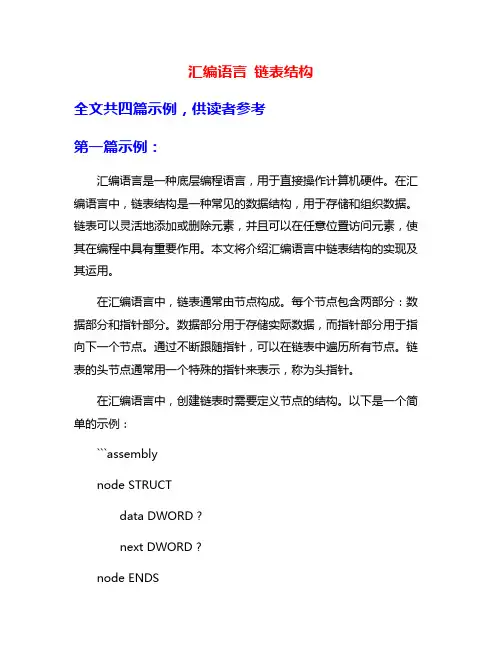
汇编语言链表结构全文共四篇示例,供读者参考第一篇示例:汇编语言是一种底层编程语言,用于直接操作计算机硬件。
在汇编语言中,链表结构是一种常见的数据结构,用于存储和组织数据。
链表可以灵活地添加或删除元素,并且可以在任意位置访问元素,使其在编程中具有重要作用。
本文将介绍汇编语言中链表结构的实现及其运用。
在汇编语言中,链表通常由节点构成。
每个节点包含两部分:数据部分和指针部分。
数据部分用于存储实际数据,而指针部分用于指向下一个节点。
通过不断跟随指针,可以在链表中遍历所有节点。
链表的头节点通常用一个特殊的指针来表示,称为头指针。
在汇编语言中,创建链表时需要定义节点的结构。
以下是一个简单的示例:```assemblynode STRUCTdata DWORD ?next DWORD ?node ENDS```上面的代码定义了一个节点结构体,包含一个数据部分和一个指向下一个节点的指针。
在实际编程中,可以根据需要定义更复杂的节点结构。
创建链表时,首先需要初始化头指针为空。
然后逐个添加节点到链表中。
以下是一个示例代码:```assembly; 初始化链表mov DWORD PTR head, 0; 添加第一个节点push 1call addNodeaddNode PROC; 申请内存空间用于新节点pushadmov edx, 8call mallocmov esi, eaxpopad; 将数据部分赋值mov DWORD PTR [esi], eax; 将指针部分赋值mov DWORD PTR [esi + 4], DWORD PTR head; 将新节点设置为头节点mov DWORD PTR head, esiretaddNode ENDP```上面的示例代码演示了如何创建一个简单的链表并向其中添加节点。
在addNode过程中,首先申请内存空间用于新节点,然后将数据部分和指针部分填充,并将新节点设置为头节点。
通过调用addNode 过程,可以逐个向链表中添加节点。

C语⾔结构体使⽤之链表⽬录⼀、结构体的概念⼆、结构体的⽤法三、结构体数组和指针四、结构体指针五、包含结构体的结构体六、链表七、静态链表⼋、动态链表⼀、结构体的概念⽐如说学⽣的信息,包含了学⽣名称、学号、性别、年龄等信息,这些参数可能有些是数组型、字符型、整型、甚⾄是结构体类型的数据。
虽然这些都是不同类型的数据,但是这些都是⽤来表达学⽣信息的数据。
⼆、结构体的⽤法1、struct 结构体名称访问⽅法:结构体变量名.成员{undefined成员1;成员2;};2、 typedef struct{undefined成员1;成员2;}结构体名称;在中⼤型产品中⼀般⽤第2种,因为结构体多了以后通过别名的⽅式定义结构体变量能够⼤⼤提⾼代码可读性。
三、结构体数组和指针1、直接⽤struct声明⼀个结构体,然后在定义结构体数组,struct 结构体名称数组名[数组⼤⼩]2、⽤typedef struct声明⼀个结构体,并且为结构体重命名,通过重命名的⽅法定义结构体数组。
结构体重命名数组名[数组⼤⼩]四、结构体指针只要是存储在内存中的变量或者数组或函数编译器都会为他们分配⼀个地址,我们可以通过指针变量指向这个地址来访问地址⾥⾯的数,只要把指针变量定义成同数据类型就可以指向了,⽐如说要指向字符型变量就定义字符型指针变量,所以我们也可以定义结构体类型指针来指向它。
1、直接⽤struct声明⼀个结构体,然后在定义结构体指针,struct 结构体名称 *结构体指针变量名2、⽤typedef struct声明⼀个结构体,并且为结构体重命名,通过别名的⽅式定义结构体指针。
结构体别名 *结构体指针变量名结构体指针访问成员⽅法结构体指针变量名->成员名五、包含结构体的结构体学⽣信息包含姓名,学号,性别,出⼊⽇期等数据,⽽出⽣⽇期⼜包含年⽉⽇这3个成员,所以把出⽣⽇期单独声明⼀个结构体,那么学⽣这个结构体就包含出⽣⽇期这个结构体,这种就是包含结构体的结构体。
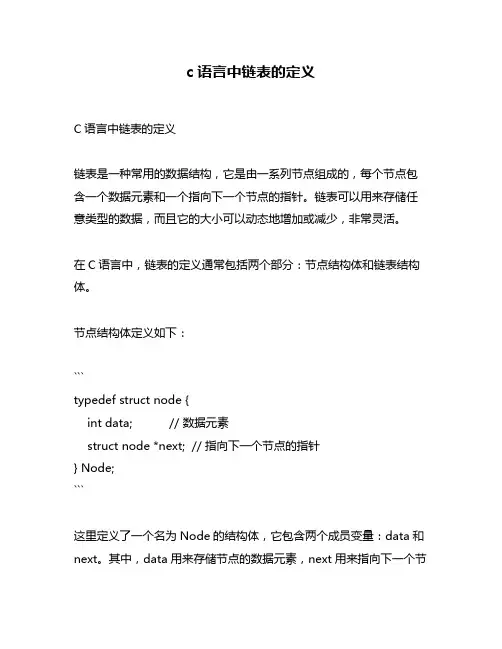
c语言中链表的定义C语言中链表的定义链表是一种常用的数据结构,它是由一系列节点组成的,每个节点包含一个数据元素和一个指向下一个节点的指针。
链表可以用来存储任意类型的数据,而且它的大小可以动态地增加或减少,非常灵活。
在C语言中,链表的定义通常包括两个部分:节点结构体和链表结构体。
节点结构体定义如下:```typedef struct node {int data; // 数据元素struct node *next; // 指向下一个节点的指针} Node;```这里定义了一个名为Node的结构体,它包含两个成员变量:data和next。
其中,data用来存储节点的数据元素,next用来指向下一个节点的指针。
注意,这里的next是一个指向Node类型的指针,这样才能实现链表的连接。
链表结构体定义如下:```typedef struct list {Node *head; // 指向链表头节点的指针Node *tail; // 指向链表尾节点的指针int size; // 链表的大小} List;```这里定义了一个名为List的结构体,它包含三个成员变量:head、tail和size。
其中,head和tail分别指向链表的头节点和尾节点,size表示链表的大小。
通过这两个结构体的定义,我们就可以创建一个链表了。
下面是一个简单的例子:```int main() {List list = {NULL, NULL, 0}; // 初始化链表Node *node1 = (Node*)malloc(sizeof(Node)); // 创建第一个节点node1->data = 1; // 设置节点的数据元素node1->next = NULL; // 设置节点的指针list.head = node1; // 将节点1设置为链表的头节点list.tail = node1; // 将节点1设置为链表的尾节点list.size++; // 链表大小加1// 创建更多的节点...return 0;}```在这个例子中,我们首先初始化了一个空链表,然后创建了第一个节点,并将它设置为链表的头节点和尾节点。

【6.1简略版】在main函数中输入一个学生的学号、姓名、性别、出生日期和3门课程的成绩,在另一函数print中输出这个学生的信息,采用结构体变函数参数。
void print( student );void main ( ){student John;// 定义一个结构体变量cin>> John.ID>> >> John.gender;cin>> John.birthday.year>> John.score[2];print(John);// 调用函数完成输出}void print( student s)// 输出参数s成员的值{cout<<"学号: " << setw(5) << s.ID<< endl;cout<< setw(5) << s.birthday.month<< endl;}使用结构体变量作函数参数效率较低,why? 可采用指向结构体变量的指针或引用作参数,例如:student *ps;student John;并且如下赋值:ps= &John;则:<=> ps->name <=> (*ps).name思考:如何将程序【例6.1】中的函数print改为传指针。
【例6.2】假设一个班级有5个学生,从键盘输入5个学生的学号、姓名、性别、出生日期和三门功课的成绩,编程输出个人平均分小于全班总均分的那些学生的信息。
struct date{int year, month, day;};struct student{int ID;char name[20];char gender;date birthday;double score[3];};void input( student*, int);double average( student *, int n); //求总的平均分void print( student*,int);const int studentNumber=5;int main ( ){student stud[5];input(stud,studentNumber);print(stud,studentNumber);return 0;}void input( student *ps, int n)// 输入函数{cout<<"请输入如下学生信息" << endl;for(int i=0;i<n; i++){cin>> ps->ID;cin>> ps->name;cin>> ps->gender;cin>> ps->birthday.year>> ps->birthday.month>> ps->birthday.day;cin>> ps->score[0] >> ps->score[1]>> ps->score[2];ps++;}}void print( student *ps, int n){ student *pStart;double averAll, averPerson;averAll=average(ps,n);cout<< "总均分: "<< averAll<<endl;for(pStart=ps;pStart<ps+n;pStart++){averPerson= (pStart->score[0]+pStart->score[1]+pStart->score[2])/3 ;if( averPerson< averAll){cout<<"\n个人均分:"<< averPerson<<endl;cout<<"学号: " << setw(5) << pStart->ID;cout<<“出生年: " << pStart->birthday.year;cout<<" 成绩: " << setw(4) << pStart->score[0];}}}double average( student stud[], int n) // 求总均分{double aver=0;for(int i=0; i<n; i++)for(int j=0;j<3;j++)aver += stud[i].score[j];aver /= n*3;return aver;}NODE *create( ) // 创建无序链表{ NODE *p1, *p2, *head;int a;cout<< "Creating a list...\n";p2 = head = initlist( );cout<< "Please input a number(if(-1) stop): ";cin>> a; // 输入第1个数据while( a != -1 ) // 循环输入数据,建立链表{ p1 = (NODE *) malloc(sizeof(NODE));p1->data = a;p2->next = p1;p2 = p1;cout<< "Please input a number(if(-1) stop): ";cin>> a; // 输入下一个数据}p2->next=NULL;return(head); // 返回创建链表的首指针}// 输出链表各结点值,也称为对链表的遍历void print( NODE *head ){NODE *p;让p指向第一个数据结点p=head->next; //if( p!=NULL ){cout<< "Output list: ";while( p!=NULL ){cout<< setw(5) << p->data;p=p->next;}cout<< "\n";}}// 查询结点数据为x的结点,返回指向该结点指针NODE * search( NODE *head, int x ){ NODE *p;p=head->next;while( p!=NULL ){if(p->data == x)return p; // 返回该结点指针p = p->next;}return NULL; // 找不到返回空指针}// 删除链表中值为num的结点,返回值: 链表的首指针NODE * delete_one_node( NODE *head, int num ) {NODE *p, *temp;p=head;while(p->next !=NULL && p->next->data != num) p=p->next;temp=p->next;if(p->next!=NULL){p->next=temp->next;free(temp);cout<< "Delete successfully";}else cout<< "Not found!";return head;}// 释放链表void free_list( NODE *head ) {NODE *p;while(head){p=head;head=head->next;free(p);}}// 插入结点,将s指向的结点插入链表,结果链表保持有序NODE * insert(NODE*head, NODE *s){NODE *p;p=head;while(p->next!=NULL && p->next->data < s->data) p=p->next;s->next=p->next;p->next=s;return head;}// 创建有序链表。
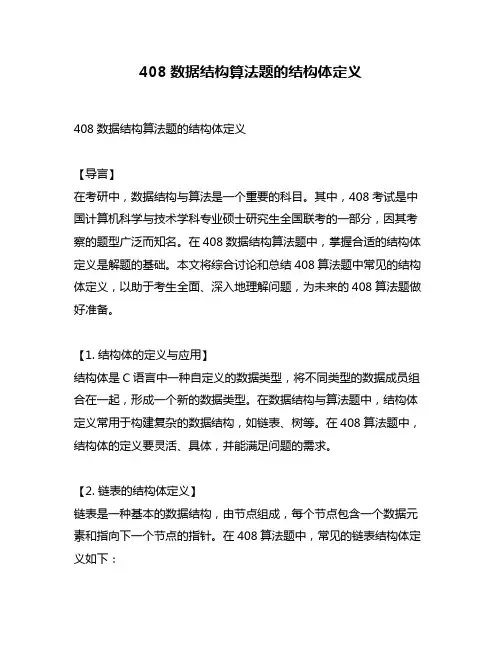
408数据结构算法题的结构体定义408数据结构算法题的结构体定义【导言】在考研中,数据结构与算法是一个重要的科目。
其中,408考试是中国计算机科学与技术学科专业硕士研究生全国联考的一部分,因其考察的题型广泛而知名。
在408数据结构算法题中,掌握合适的结构体定义是解题的基础。
本文将综合讨论和总结408算法题中常见的结构体定义,以助于考生全面、深入地理解问题,为未来的408算法题做好准备。
【1. 结构体的定义与应用】结构体是C语言中一种自定义的数据类型,将不同类型的数据成员组合在一起,形成一个新的数据类型。
在数据结构与算法题中,结构体定义常用于构建复杂的数据结构,如链表、树等。
在408算法题中,结构体的定义要灵活、具体,并能满足问题的需求。
【2. 链表的结构体定义】链表是一种基本的数据结构,由节点组成,每个节点包含一个数据元素和指向下一个节点的指针。
在408算法题中,常见的链表结构体定义如下:```ctypedef struct ListNode {int val; // 数据元素struct ListNode* next; // 指向下一个节点的指针} ListNode;```上述代码中,定义了一个名为ListNode的结构体,包含一个整型数据元素val和一个指向下一个节点的指针next。
该结构体可以用于构建单链表,每个节点存储了一个整数值和指向下一个节点的指针。
【3. 树的结构体定义】树是一种重要的数据结构,由节点组成,每个节点可以有零个或多个子节点。
在408算法题中,常见的树结构体定义如下:```ctypedef struct TreeNode {int val; // 数据元素struct TreeNode* left; // 左子节点struct TreeNode* right; // 右子节点} TreeNode;```上述代码中,定义了一个名为TreeNode的结构体,包含一个整型数据元素val和左右子节点的指针left和right。
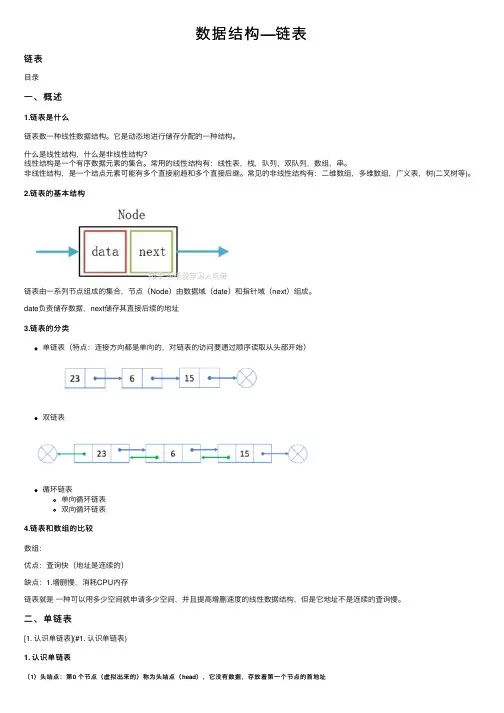
数据结构—链表链表⽬录⼀、概述1.链表是什么链表数⼀种线性数据结构。
它是动态地进⾏储存分配的⼀种结构。
什么是线性结构,什么是⾮线性结构?线性结构是⼀个有序数据元素的集合。
常⽤的线性结构有:线性表,栈,队列,双队列,数组,串。
⾮线性结构,是⼀个结点元素可能有多个直接前趋和多个直接后继。
常见的⾮线性结构有:⼆维数组,多维数组,⼴义表,树(⼆叉树等)。
2.链表的基本结构链表由⼀系列节点组成的集合,节点(Node)由数据域(date)和指针域(next)组成。
date负责储存数据,next储存其直接后续的地址3.链表的分类单链表(特点:连接⽅向都是单向的,对链表的访问要通过顺序读取从头部开始)双链表循环链表单向循环链表双向循环链表4.链表和数组的⽐较数组:优点:查询快(地址是连续的)缺点:1.增删慢,消耗CPU内存链表就是⼀种可以⽤多少空间就申请多少空间,并且提⾼增删速度的线性数据结构,但是它地址不是连续的查询慢。
⼆、单链表[1. 认识单链表](#1. 认识单链表)1. 认识单链表(1)头结点:第0 个节点(虚拟出来的)称为头结点(head),它没有数据,存放着第⼀个节点的⾸地址(2)⾸节点:第⼀个节点称为⾸节点,它存放着第⼀个有效的数据(3)中间节点:⾸节点和接下来的每⼀个节点都是同⼀种结构类型:由数据域(date)和指针域(next)组成数据域(date)存放着实际的数据,如学号(id)、姓名(name)、性别(sex)、年龄(age)、成绩(score)等指针域(next)存放着下⼀个节点的⾸地址(4)尾节点:最后⼀个节点称为尾节点,它存放着最后⼀个有效的数据(5)头指针:指向头结点的指针(6)尾指针:指向尾节点的指针(7)单链表节点的定义public static class Node {//Object类对象可以接收⼀切数据类型解决了数据统⼀问题public Object date; //每个节点的数据Node next; //每个节点指向下⼀结点的连接public Node(Object date) {this.date = date;}}2.引⼈头结点的作⽤1. 概念头结点:虚拟出来的⼀个节点,不保存数据。

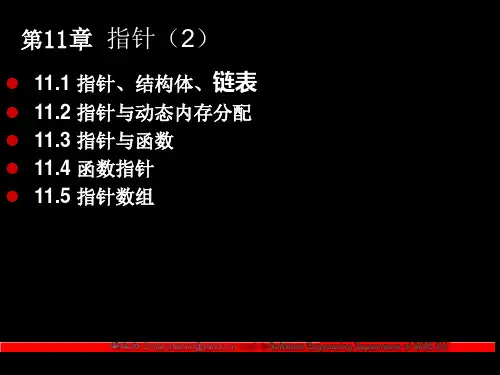
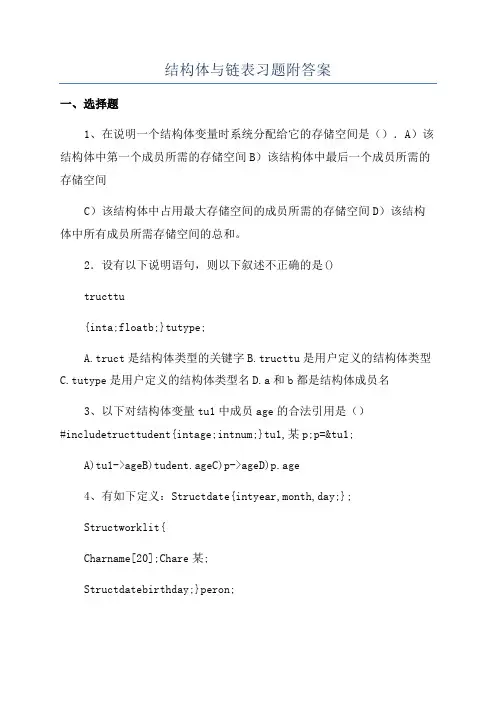
结构体与链表习题附答案一、选择题1、在说明一个结构体变量时系统分配给它的存储空间是().A)该结构体中第一个成员所需的存储空间B)该结构体中最后一个成员所需的存储空间C)该结构体中占用最大存储空间的成员所需的存储空间D)该结构体中所有成员所需存储空间的总和。
2.设有以下说明语句,则以下叙述不正确的是()tructtu{inta;floatb;}tutype;A.truct是结构体类型的关键字B.tructtu是用户定义的结构体类型C.tutype是用户定义的结构体类型名D.a和b都是结构体成员名3、以下对结构体变量tu1中成员age的合法引用是()#includetructtudent{intage;intnum;}tu1,某p;p=&tu1;A)tu1->ageB)tudent.ageC)p->ageD)p.age4、有如下定义:Structdate{intyear,month,day;};Structworklit{Charname[20];Chare某;Structdatebirthday;}peron;对结构体变量peron的出生年份进行赋值时,下面正确的赋值语句是()Aworklit.birthday.year=1978Bbirthday.year=1978Cperon.birthday .year=1958Dperon.year=19585、以下程序运行的结果是()#include”tdio.h”main(){tructdate{intyear,month,day;}today;printf(“%d\\n”,izeof(truct date));}A.6B.8C.10D.126、对于时间结构体tructdate{intyear,month,day;charweek[5];}则执行printf(“%d\\n”,izeof(tructdate))的输出结果为(A.12B.17C.18D.207、设有以下语句:tructt{intn;charname[10]};tructta[3]={5,“li”,7,“wang”,9,”zhao”},某p;p=a;则以下表达式的值为6的是()A.p++->nB.p->n++C.(某p).n++D.++p->n8、设有以下语句,则输出结果是()tructLit{intdata;tructLit某ne某t;};tructLita[3]={1,&a[1],2,&a[2],3,&a[0]},某p;p=&a[1];printf(\printf(\printf(\}A.131B.311C.132D.2139、若有以下语句,则下面表达式的值为1002的是()tructtudent{intage;intnum;};tructtudenttu[3]={{1001,20},{1002,19},{1003,21}};)tructtudent某p;p=tu;A.(p++)->numB.(p++)->ageC.(某p).numD.(某++p).age10、下若有以下语句,则下面表达式的值为()tructcmpl某{int某;inty;}cnumn[2]={1,3,2,7};cnum[0].y/cnum[0].某某cnum[1].某;A.0B.1C.3D.611、若对员工数组进行排序,下面函数声明最合理的为()。
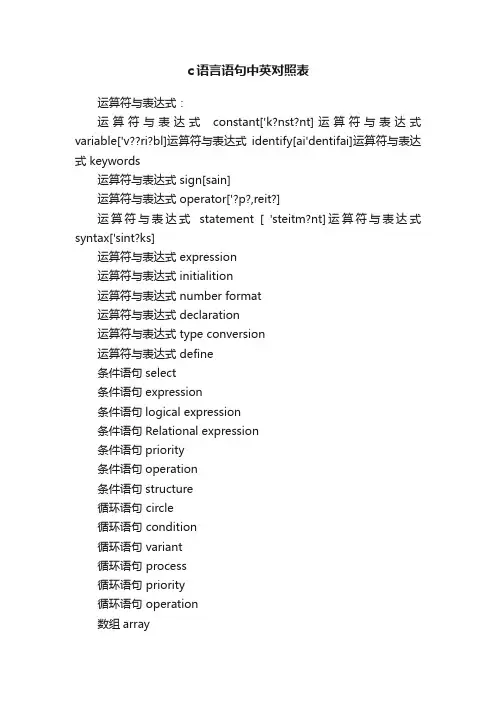
c语言语句中英对照表运算符与表达式:运算符与表达式constant['k?nst?nt]运算符与表达式variable['v??ri?bl]运算符与表达式identify[ai'dentifai]运算符与表达式 keywords运算符与表达式 sign[sain]运算符与表达式 operator['?p?,reit?]运算符与表达式statement['steitm?nt]运算符与表达式syntax['sint?ks]运算符与表达式 expression运算符与表达式 initialition运算符与表达式 number format运算符与表达式 declaration运算符与表达式 type conversion运算符与表达式 define条件语句select条件语句expression条件语句logical expression条件语句Relational expression条件语句priority条件语句operation条件语句structure循环语句 circle循环语句 condition循环语句 variant循环语句 process循环语句 priority循环语句 operation数组array数组reference数组element数组address数组sort数组character数组string数组application函数:call函数:return value函数:function函数:declare函数:parameter函数:static函数:extern指针:argument指针:array指针:declaration指针:represent指针:manipulate结构体共用体链表1structure 结构体共用体链表2member 结构体共用体链表3tag结构体共用体链表4function 结构体共用体链表5enumerate 结构体共用体链表6union结构体共用体链表7create结构体共用体链表8insert结构体共用体链表9delete结构体共用体链表10 modify 文件1file文件2open文件3close文件4read文件5write文件6error文件7Program Design文件8writing program文件9standardize vt.文件10coding the program 文件11simplify vt. 文件12programming文件13revision n.文件14programmer n.文件15occupy vt.文件16logic n.文件17BASIC文件18machine code文件19teaching language文件20debug n.DOS文件21simplicity n.文件22compactness a.文件23timesharing system 文件24description n. 文件25interactive language 文件26break n.文件27manufacturer n.文件28structure chart文件30the program flow文件31expense n.文件32manager module文件33uniformity n.文件34worder module文件35archaic a.文件36mainmodule文件37sufficient a.文件38submodule文件39data processing文件40modify v.文件41business application 文件42outline n.文件43scientific application 文件44compose文件45lexical a.文件46code文件47non-programmer n.文件48node vt文件49notation n.文件50pseudocode n.文件51verbosity n.文件52commas n.文件53record n.文件54documentation文件55subrecord n.文件56flowchart/flow文件57data division文件58visual a.文件59procedure division文件60represent vt.文件61comprise vt.文件62structured techniques 文件63operator n. 文件64straightforward a.文件65commercial package文件66subroutine n.文件67generator n.文件68driver module文件69mathematician n.文件70line by line文件71operator n.文件72translate vt.文件74modular文件75ancestor n.文件76cumbersome a.文件77teaching programming 文件78lengthy a. 文件79alter vi./vt.文件80flaw n.文件81devclop vt.文件82separate a.文件83recompile v.文件84assist n.文件85cycle n.文件86technician n.文件87remove vt.文件88straight line文件89category n.文件90rectangle n.文件91P-code p文件92virtrally ad.文件93symology n.文件94register n.文件95to summaries文件96by convention文件97cyptic n.文件98diamond-shaped a,文件99bracket n.文件100decision n文件101obviate文件102terminal n. a文件103keyword n.文件104card reader文件105underline vt.文件106translator program 文件107monadic a. monad( 文件108Programming文件109dec/binary n.文件110source language文件111shift文件112machine language文件113overflow n.文件114machine instruction 文件115arithmetic n.文件116computer language文件118assembly language文件119assignment n.文件120floating point number 文件121proliferation n.文件122high-level language 文件123pointer n.文件124natural language文件125array n.文件126source text文件127subscript n.文件128intermediate language 文件129type conversion 文件130software development 文件131address arithmetic 文件132map vt.文件133denote vt.文件134maintenance cost文件135subprogram n.文件136legibility n.文件137separate compilation 文件138amend vt.文件139alphabetic a.文件140consumer n.文件141digit n.文件142enormous a.文件143numeric expression文件144reliability n.文件145tap n.文件146safety n.文件147print zone文件148property n.文件149column n.文件150correctness n.文件151functionality n.文件152semicolon n.文件153portable a.文件154survey n.文件155altoggle n.文件156task n.文件157declaration n.文件158source program文件159mufti-dimension array 文件160object program 其他提示语4ROM(Read Only Memory)其他提示语5Floppy Disk其他提示语6Hard Disk其他提示语7CD-ROM其他提示语8monitor其他提示语9keyboard其他提示语10mouse其他提示语11chip其他提示语12CD-R其他提示语14Modem= MOdulator-DEModulator,其他提示语15P-P(Plug and Play)其他提示语16UPS(Uninterruptable PowerSupply)其他提示语17System)其他提示语18CMOS(Complementary Metal-Oxide-Semiconductor)其他提示语19setup其他提示语20uninstall其他提示语21wizzard其他提示语22OS(Operation Systrem)其他提示语23OA(Office AutoMation)其他提示语24exit其他提示语25edit其他提示语26copy其他提示语27cut其他提示语28paste其他提示语29delete其他提示语30select其他提示语31find其他提示语32select all其他提示语33replace其他提示语34undo其他提示语35redo其他提示语36program其他提示语37license其他提示语38back其他提示语39next其他提示语40finish其他提示语42Destination Folder其他提示语43user其他提示语44click其他提示语48update其他提示语49release其他提示语50data其他提示语51data base其他提示语52System)其他提示语53view其他提示语54insert其他提示语55object其他提示语56configuration其他提示语57command其他提示语58document其他提示语59POST(power-on-self-test)其他提示语60cursor 其他提示语61attribute其他提示语62icon其他提示语63service pack其他提示语64option pack其他提示语65Demo其他提示语66short cut其他提示语67exception其他提示语68debug其他提示语69previous其他提示语70column其他提示语71row其他提示语72restart其他提示语73text其他提示语74font其他提示语76scale其他提示语77interface其他提示语78function其他提示语79access其他提示语80manual其他提示语81active其他提示语82computer language 其他提示语83menu其他提示语84interfaces )其他提示语85template其他提示语86page setup其他提示语87password其他提示语88code其他提示语90zoom in其他提示语91zoom out其他提示语92pan其他提示语93cruise其他提示语94full screen其他提示语95tool bar其他提示语96status bar其他提示语97ruler其他提示语98table其他提示语99paragraph其他提示语100symbol其他提示语101style其他提示语102execute其他提示语103graphics其他提示语104image其他提示语105Unix其他提示语106Mac OS其他提示语107OO(Object-Oriented)其他提示语108virus其他提示语109file其他提示语110open其他提示语111colse其他提示语112new其他提示语113save其他提示语114exit其他提示语115clear其他提示语116default其他提示语117LAN其他提示语118WAN其他提示语119Client/Server其他提示语120Transfer Mode)其他提示语121Windows NT其他提示语122Internet其他提示语123WWW(World Wide Web)其他提示语124protocol其他提示语125HTTP其他提示语126FTP其他提示语127Browser其他提示语128homepage其他提示语129Webpage其他提示语130website其他提示语131URL用于指定信息位置的表示方法1Online用于指定信息位置的表示方法3ICQ用于指定信息位置的表示方法4Firewall用于指定信息位置的表示方法5Gateway用于指定信息位置的表示方法6HTML用于指定信息位置的表示方法7hypertext 用于指定信息位置的表示方法8hyperlink 用于指定信息位置的表示方法9IP(Address) 用于指定信息位置的表示方法10SearchEngine用于指定信息位置的表示方法11TCP/IP用于指定信息位置的表示方法12Telnet用于指定信息位置的表示方法13IE(Internet Explorer)用于指定信息位置的表示方法14Navigator用于指定信息位置的表示方法15multimedia用于指定信息位置的表示方法16ISO用于指定信息位置的表示方法17ANSI用于指定信息位置的表示方法18able用于指定信息位置的表示方法19activefile用于指定信息位置的表示方法20addwatch用于指定信息位置的表示方法21allfiles用于指定信息位置的表示方法22allrightsreserved用于指定信息位置的表示方法23altdirlst用于指定信息位置的表示方法24andfixamuchwiderrangeofdiskprobl ems用于指定信息位置的表示方法25andotherinFORMation用于指定信息位置的表示方法26archivefileattribute用于指定信息位置的表示方法27assignto用于指定信息位置的表示方法28autoanswer用于指定信息位置的表示方法29autodetect用于指定信息位置的表示方法30autoindent用于指定信息位置的表示方法31autosave用于指定信息位置的表示方法32availableonvolume用于指定信息位置的表示方法33badcommand用于指定信息位置的表示方法34badcommandorfilename用于指定信息位置的表示方法35batchparameters用于指定信息位置的表示方法36binaryfile用于指定信息位置的表示方法37binaryfiles用于指定信息位置的表示方法38borlandinternational borland 用于指定信息位置的表示方法39bottommargin用于指定信息位置的表示方法40bydate用于指定信息位置的表示方法41byextension用于指定信息位置的表示方法42byname用于指定信息位置的表示方法43bytesfree用于指定信息位置的表示方法44callstack用于指定信息位置的表示方法45casesensitive用于指定信息位置的表示方法47centralpointsoftwareinc central point用于指定信息位置的表示方法48changedirectory用于指定信息位置的表示方法49changedrive用于指定信息位置的表示方法50changename用于指定信息位置的表示方法51characterset用于指定信息位置的表示方法52checkingfor用于指定信息位置的表示方法53checksadiskanddisplaysastatusrep ort用于指定信息位置的表示方法54chgdrivepath用于指定信息位置的表示方法55node用于指定信息位置的表示方法56npasswd UNIX用于指定信息位置的表示方法57OSPF用于指定信息位置的表示方法58OSI Model用于指定信息位置的表示方法59out-of-band attack用于指定信息位置的表示方法60packet filter用于指定信息位置的表示方法61password用于指定信息位置的表示方法62path用于指定信息位置的表示方法63payload用于指定信息位置的表示方法65PCS用于指定信息位置的表示方法66peer用于指定信息位置的表示方法67permission用于指定信息位置的表示方法68plaintext用于指定信息位置的表示方法69PPTP用于指定信息位置的表示方法70port用于指定信息位置的表示方法71prority用于指定信息位置的表示方法72protocol用于指定信息位置的表示方法73potential browser 用于指定信息位置的表示方法74POP用于指定信息位置的表示方法75IMAP用于指定信息位置的表示方法76process用于指定信息位置的表示方法77proxy用于指定信息位置的表示方法78proxy server用于指定信息位置的表示方法79用于指定信息位置的表示方法80paseudorandom 用于指定信息位置的表示方法81phreaking用于指定信息位置的表示方法82RAS用于指定信息位置的表示方法83Remote control 用于指定信息位置的表示方法84RPC用于指定信息位置的表示方法85remote boot用于指定信息位置的表示方法86route用于指定信息位置的表示方法87router用于指定信息位置的表示方法88routing用于指定信息位置的表示方法89RIP用于指定信息位置的表示方法91routing table用于指定信息位置的表示方法93RSA用于指定信息位置的表示方法94script用于指定信息位置的表示方法95search engine用于指定信息位置的表示方法96SSL用于指定信息位置的表示方法97secure用于指定信息位置的表示方法98SID用于指定信息位置的表示方法99sender用于指定信息位置的表示方法100SLIP用于指定信息位置的表示方法101server用于指定信息位置的表示方法102server-based network 用于指定信息位置的表示方法103session layer用于指定信息位置的表示方法104share用于指定信息位置的表示方法105share-level security 用于指定信息位置的表示方法106SMTP用于指定信息位置的表示方法107SNMP用于指定信息位置的表示方法108Site用于指定信息位置的表示方法109SCSI用于指定信息位置的表示方法110snffer用于指定信息位置的表示方法111snooping用于指定信息位置的表示方法112standalone server用于指定信息位置的表示方法113strong cipher用于指定信息位置的表示方法114stream cipher用于指定信息位置的表示方法115strong password用于指定信息位置的表示方法116SQL用于指定信息位置的表示方法117subnet mask用于指定信息位置的表示方法118subdirectory用于指定信息位置的表示方法119subnet用于指定信息位置的表示方法120swap file用于指定信息位置的表示方法121SACL用于指定信息位置的表示方法123sniffer用于指定信息位置的表示方法124spoofing用于指定信息位置的表示方法125time bomb用于指定信息位置的表示方法126TCPDUMP用于指定信息位置的表示方法127Traceroute用于指定信息位置的表示方法128T0,DS0 56用于指定信息位置的表示方法129T1,DS1 24用于指定信息位置的表示方法130T3,DS3 28用于指定信息位置的表示方法131thin client用于指定信息位置的表示方法132thread用于指定信息位置的表示方法133throughput用于指定信息位置的表示方法135Transport Protocol 用于指定信息位置的表示方法136trust用于指定信息位置的表示方法137tunnel用于指定信息位置的表示方法138vector of attack 用于指定信息位置的表示方法139Virtual directory 用于指定信息位置的表示方法140Virtual Machine 用于指定信息位置的表示方法141VRML用于指定信息位置的表示方法142volume用于指定信息位置的表示方法143vulnerability用于指定信息位置的表示方法144weak passwurd用于指定信息位置的表示方法145well-known ports 用于指定信息位置的表示方法146workstation用于指定信息位置的表示方法147X.25用于指定信息位置的表示方法148zone transfer用于指定信息位置的表示方法149authentication用于指定信息位置的表示方法150authorization用于指定信息位置的表示方法151Back Office Microsoft 用于指定信息位置的表示方法152Back up用于指定信息位置的表示方法153backup browser用于指定信息位置的表示方法154BDC用于指定信息位置的表示方法155baseline用于指定信息位置的表示方法156BIOS用于指定信息位置的表示方法157Binding用于指定信息位置的表示方法158bit用于指定信息位置的表示方法159BOOTP用于指定信息位置的表示方法160BGP用于指定信息位置的表示方法161Bottleneck用于指定信息位置的表示方法162bridge用于指定信息位置的表示方法163browser用于指定信息位置的表示方法164browsing用于指定信息位置的表示方法165channel 用于指定信息位置的表示方法166CSU/DSU用于指定信息位置的表示方法167Checksum用于指定信息位置的表示方法168Cluster用于指定信息位置的表示方法169CGI用于指定信息位置的表示方法170CGI用于指定信息位置的表示方法171CGI-based attack用于指定信息位置的表示方法172用于指定信息位置的表示方法173crash用于指定信息位置的表示方法174CD-ROM用于指定信息位置的表示方法175Component用于指定信息位置的表示方法176data link用于指定信息位置的表示方法177---- include用于指定信息位置的表示方法178stdio.h用于指定信息位置的表示方法179void用于指定信息位置的表示方法180main用于指定信息位置的表示方法181printf用于指定信息位置的表示方法182IDE(Integrated Development Environment)用于指定信息位置的表示方法183source File用于指定信息位置的表示方法184warning用于指定信息位置的表示方法185Project用于指定信息位置的表示方法186------ int用于指定信息位置的表示方法187short int用于指定信息位置的表示方法188unsigned short int用于指定信息位置的表示方法189long int用于指定信息位置的表示方法190float用于指定信息位置的表示方法191double用于指定信息位置的表示方法192char用于指定信息位置的表示方法193scanf用于指定信息位置的表示方法194getchar()用于指定信息位置的表示方法195putchar()用于指定信息位置的表示方法196variable用于指定信息位置的表示方法197Compiler用于指定信息位置的表示方法199Date type用于指定信息位置的表示方法200Console用于指定信息位置的表示方法201Declaration用于指定信息位置的表示方法202Initialization用于指定信息位置的表示方法203------ TRUE用于指定信息位置的表示方法204FALSE用于指定信息位置的表示方法205if用于指定信息位置的表示方法206else用于指定信息位置的表示方法207Sizeof用于指定信息位置的表示方法208------ Switch用于指定信息位置的表示方法209case用于指定信息位置的表示方法210break用于指定信息位置的表示方法211default用于指定信息位置的表示方法212------ While用于指定信息位置的表示方法215用于指定信息位置的表示方法216Counter用于指定信息位置的表示方法217fflush用于指定信息位置的表示方法218------ Array用于指定信息位置的表示方法219dimension用于指定信息位置的表示方法220Single Dimensional Array用于指定信息位置的表示方法221Double Dimensional Array用于指定信息位置的表示方法222Multiplication dimensional Array用于指定信息位置的表示方法223sorting用于指定信息位置的表示方法224Bubble sort用于指定信息位置的表示方法225Ascending order用于指定信息位置的表示方法226Descending order用于指定信息位置的表示方法227subscript用于指定信息位置的表示方法229Row用于指定信息位置的表示方法230column用于指定信息位置的表示方法231traverse用于指定信息位置的表示方法232------ pointer用于指定信息位置的表示方法233Address用于指定信息位置的表示方法234Base Address用于指定信息位置的表示方法235Memory Member用于指定信息位置的表示方法236Relational operator用于指定信息位置的表示方法237Arithmetic operator用于指定信息位置的表示方法238Assignment operator 用于指定信息位置的表示方法239Logical operator用于指定信息位置的表示方法240------ function用于指定信息位置的表示方法241Build-in function用于指定信息位置的表示方法242User Defined Function 用于指定信息位置的表示方法243Recursive function用于指定信息位置的表示方法244Random用于指定信息位置的表示方法245power用于指定信息位置的表示方法246prototype用于指定信息位置的表示方法247void用于指定信息位置的表示方法248Called function用于指定信息位置的表示方法249Calling function用于指定信息位置的表示方法250return用于指定信息位置的表示方法251------ scope用于指定信息位置的表示方法252Parameter用于指定信息位置的表示方法253Parameterized function 用于指定信息位置的表示方法254Local variable用于指定信息位置的表示方法255Global variable用于指定信息位置的表示方法256static用于指定信息位置的表示方法257auto259用于指定信息位置的表示方法260Formal parameter 用于指定信息位置的表示方法261Actual parameter 用于指定信息位置的表示方法262Call by reference 用于指定信息位置的表示方法263Call by value用于指定信息位置的表示方法264------ String用于指定信息位置的表示方法265String literal用于指定信息位置的表示方法266sequence用于指定信息位置的表示方法267queue用于指定信息位置的表示方法268Puts()用于指定信息位置的表示方法269Gets()用于指定信息位置的表示方法270string.h用于指定信息位置的表示方法271strlen()用于指定信息位置的表示方法272strcpy()用于指定信息位置的表示方法273strcmp()用于指定信息位置的表示方法274strcat()用于指定信息位置的表示方法275------ struct用于指定信息位置的表示方法276stack用于指定信息位置的表示方法277structure用于指定信息位置的表示方法278Structured programming用于指定信息位置的表示方法279member(Common Gateway Interface公用网关接口是一个可以产生相同结果或结而变化的程序。

结构体指针:指针的基类型为结构体类型的指针结构体指针变量的定义1.必须存在一个已经定义了的结构体类型2.用该结构体类型作为基类型来定义结构体指针变量如何通过结构体指针变量访问结构体数据1.让该结构体指针变量指向一个结构体变量2.指针变量名->成员、(*指针变量名).成员结构体变量作为函数的参数结构体指针做函数参数引用通过一个函数交换两个结构体变量的值(指针法、引用)#include <iostream>using namespace std;struct student{int num;char name[10];};void swap(student &p1,student &p2){student temp;temp=p1;p1=p2;p2=temp;}int main(){student stu1,stu2;stu1.num=1001;stu2.num=1002;strcpy(,"zhang");strcpy(,"cheng");swap(stu1,stu2);cout<<stu1.num<<" "<<<<endl;cout<<stu2.num<<" "<<<<endl;return 0;}#include <iostream>using namespace std;struct student{int num;char name[10];void swap(student *p1,student *p2){student temp;temp=*p1;*p1=*p2;*p2=temp;}int main(){student stu1,stu2;stu1.num=1001;stu2.num=1002;strcpy(,"zhang");strcpy(,"cheng");swap(&stu1,&stu2);cout<<stu1.num<<" "<<<<endl;cout<<stu2.num<<" "<<<<endl;return 0;}如果要通过一个函数来实现结构体中分量的交换,可以通过多种方式:1.将需要交换的分量(成员)作为参数(指针法、引用)#include <iostream>using namespace std;struct student{int num;char name[10];};void swap(int &p1,int &p2){int temp;temp=p1;p1=p2;p2=temp;}int main(){student stu1,stu2;stu1.num=1001;stu2.num=1002;strcpy(,"zhang");strcpy(,"cheng");swap(stu1.num,stu2.num);cout<<stu1.num<<" "<<<<endl;cout<<stu2.num<<" "<<<<endl;return 0;}#include <iostream>using namespace std;struct student{int num;char name[10];};void swap(int *p1,int *p2){int temp;temp=*p1;*p1=*p2;*p2=temp;}int main(){student stu1,stu2;stu1.num=1001;stu2.num=1002;strcpy(,"zhang");strcpy(,"cheng");swap(&stu1.num,&stu2.num);cout<<stu1.num<<" "<<<<endl;cout<<stu2.num<<" "<<<<endl;return 0;}2.将结构体整个作为参数,但在实现交换的函数中,交换的是结构体的分量(指针法、引用)#include <iostream>using namespace std;struct student{int num;char name[10];};void swap(student *p1,student *p2){int temp;temp=p1->num;p1->num=p2->num;p2->num=temp;}int main(){student stu1,stu2;stu1.num=1001;stu2.num=1002;strcpy(,"zhang");strcpy(,"cheng");swap(&stu1,&stu2);cout<<stu1.num<<" "<<<<endl;cout<<stu2.num<<" "<<<<endl;return 0;}#include <iostream>using namespace std;struct student{int num;char name[10];};void swap(student &p1,student &p2){int temp;temp=p1.num;p1.num=p2.num;p2.num=temp;}int main(){student stu1,stu2;stu1.num=1001;stu2.num=1002;strcpy(,"zhang");strcpy(,"cheng");swap(stu1,stu2);cout<<stu1.num<<" "<<<<endl;cout<<stu2.num<<" "<<<<endl;return 0;}链表:(链表中的数据称为结点)为了能够将各个独立的结构体变量链接成一个整体,我们可以将这多个变量构成一个链表。
c语言链表定义链表是一种非常基础的数据结构,它的定义可以用多种编程语言来实现,其中最为常见的就是C语言。
本文将着重介绍C语言的链表定义。
第一步:首先,我们需要定义一个链表节点的结构体,用来存储链表中每个节点的数据信息以及指向下一个节点的指针。
具体代码如下所示:```struct ListNode {int val;struct ListNode *next;};```在这个结构体中,我们定义了两个成员变量,一个是表示节点值的val,一个是表示指向下一个节点的指针next。
其中,节点值可以是任意类型的数据,而指针next则是一个指向结构体类型的指针。
第二步:我们需要定义链表的头节点,通常会将头节点的指针定义为一个全局变量,方便在程序的不同部分中都能够访问。
这个头节点的作用是指向链表的第一个节点,同时也充当了哨兵节点的作用,使得链表的操作更加方便。
具体代码如下所示:```struct ListNode *list_head = NULL;```在这个全局变量中,我们定义了一个指向链表头节点的指针list_head,并将它初始化为NULL,表示目前链表为空。
第三步:链表的基本操作主要包括创建、插入、删除和遍历等。
我们将逐一介绍它们的定义方法。
1. 创建链表创建链表时,我们需要动态地分配内存,以保证每个节点的空间都是连续的而不会被覆盖。
具体代码如下所示:```struct ListNode *create_list(int arr[], int n) {struct ListNode *head = NULL, *tail = NULL;for (int i = 0; i < n; i++) {struct ListNode *node = (struct ListNode*)malloc(sizeof(struct ListNode));node->val = arr[i];node->next = NULL;if (head == NULL) {head = node;tail = node;} else {tail->next = node;tail = node;}}return head;}```在这个代码中,我们首先定义了链表的头节点head和尾节点tail,并将它们初始化为空。
结构体与链表11.1 结构体类型的定义结构体是由C语言中的基本数据类型构成的、并用一个标识符来命名的各种变量的组合,其中可以使用不同的数据类型。
1.结构体类型的定义Struct结构体名{ 类型标识符1 成员名1;类型标识符2 成员名2;……类型标识符n 成员名n;};Struct结构体名——结构体类型名2.关于结构体类型的说明:(1)“struct 结构体名”是一个类型名,它和int、float等作用一样可以用来定义变量。
(2)结构体名是结构体的标识符不是变量名,也不是类型名。
(3)构成结构体的每一个类型变量称为结构体成员,它像数组的元素一样,单数组中元素以下标来访问,而结构体是按结构体变量名来访问成员的。
(4)结构体中的各成员既可以属于不同的类型,也可以属于相同的类型。
(5)成员也可以是一个结构体类型,如:Struct date{Int month;Int day;Int year;};Struct person{Float num;Char name[20];Char sex;Int age;Struct date birthday;Char address[10];};11.2 结构体类型变量11.2.1 结构体类型变量的定义1.先定义结构体类型,再定义结构体变量形式:Struct 结构体名{类型标识符1 成员名1;类型标识符2 成员名2;……类型标识符n 成员名n;};Struct 结构体名变量名表;例如:Struct student{char name[20];Char sex;Int age;Float score;};Struct student stu1,stu2;2.在定义结构体类型的同时定义变量形式:Struct 结构体名{类型标识符1 成员名1;类型标识符2 成员名2;……类型标识符n 成员名n;}变量名表;例如:Struct student{Char name[20];Char sex;Int age;Float score;}stu1,stu2;3.用匿名形式直接定义结构体类型变量形式:Struct{类型标识符1 成员名1;类型标识符2 成员名2;……类型标识符n 成员名n;}变量名表;例如:StructChar naem[20];Char sex;Int age;Float score;}stu1,stu2;11.2.2 结构体变量的使用结构体是一种新的数据类型,因此结构体变量也可以像其它类型的变量一样赋值、运算,不同的是结构体变量以成员作为基本变量。